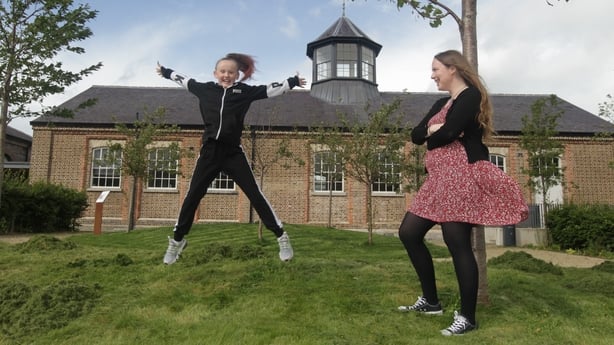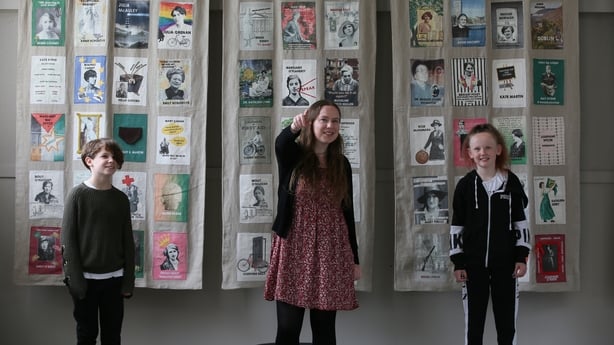History is everywhere! Historian-in-Residence for Children Dervilia Roche offers a few suggestions for young people interested in exploring local history...
My name is Dervilia Roche and, since September 2020, I've been working as Dublin's first Historian-in-Residence for Children.
My work involves engaging with children aged 9 - 12 to bring the past to life, planting the seeds for a lifelong connection to history. The residency is made by Dublin City Council Culture Company in partnership with Dublin City Libraries.
My role is based in Richmond Barracks in Dublin 8, a building and area with their own fascinating stories, and I look forward to hosting in person events there in the coming months.
During lockdown, my workshops and activities have taken place online. Working in this way was new territory for me and definitely had it's challenges, but it also allowed me to explore new ways of connecting with budding historians.
Recently, I invited children to explore history in their local area and share their discoveries and questions with me through video footage. The videos I received illustrate the interest and curiosity so many children have in exploring their surroundings.They often consider details that many of us might miss, such as small architectural features and unusual place-names.
There are stories behind every part of the city, and uncovering them can really help us to feel more connected to our neighbourhoods. If you and your family would like to seek out the hidden history of your own local area, I have a few tips to help you get started...

LOOK UP
My first piece of advice would be: go exploring! Take a walk and really look around. A simple but great tip I remember from architectural history lecturers is "look up!". You might be surprised to notice unusual features, decorations or text on buildings when you look up high, particularly in the city centre. Have a look at plaques and information panels, sculptures, and even old bridges and walls. Some features will look obviously older, so you may already be able to see layers of history. Children might like to photograph or sketch the features that interest them, and will definitely notice details that everyone else has missed.
MAPS AND PHOTOS
Next, to dig deeper, there are many free online resources you can use. Historical maps of Dublin can be accessed on a number of websites, including the Ordnance Survey Ireland National Townland and Historical Map Viewer.
These can be used to find out about which features in the area are oldest, and buildings that are no longer around. You may also see street names that have changed over the years, and rivers that have since been covered over. It can be a fun project for children (or adults!) to compare and contrast the area now to what's on the old maps.
There are also online maps of things like national monuments, and buildings that are on the National Inventory of Architectural Heritage. Other sites of historical interest can be found on the Heritage Council’s Heritage Maps. On these, you might discover that a building near you used to have a really interesting function, or that an important archaeological excavation has taken place in your neighbourhood.
Historical photos of many areas can be found on the National Library of Ireland website, and others. There are also online archives of video footage, on which you can search for your local place also.
ARCHIVES AND RECORDS
To piece together the stories of individual people, you can delve even deeper by accessing online records, such as census records, or baptism, marriage and death records. These are all free to access, and can give you a great sense of who used to live in your area, their occupations, and much more.
ORAL HISTORIES
One of the best ways to learn about local history is to talk to people. So much of our local history has never been written down, and older people in the area are sure to have stories about your neighbourhood. A phonecall about local history and memories can also be a great way for children to chat to their grandparents or other relatives.
To find out more about the stories of your area, you can also look up the National Folklore Collection. Many of these stories were collected by children in the 1930s, and tell us much about old customs and traditions.

VISIT THE LIBRARY
With libraries reopened, be sure to pay your local branch a visit. Many Dublin City libraries have sections on local history, with publications from local historians and history groups, and your librarian can help point you and your children in the right direction.
These are just some of the ways we can begin to discover our neighbourhood’s past, and hopefully you and your family will make some exciting discoveries as you piece together the layers of history in your local area. Good luck exploring!
If you would like to know more about experimenting, learning and sharing through history with the Historian-in-Residence for Children, you can get in touch with me at residency@dublincitycouncilculturecompany.ie.
Dervilia will be running free history workshops for children throughout August. Full info and bookings here. Read more about Dublin City Council Culture Culture Company and its cultural initiatives across Dublin City here.

